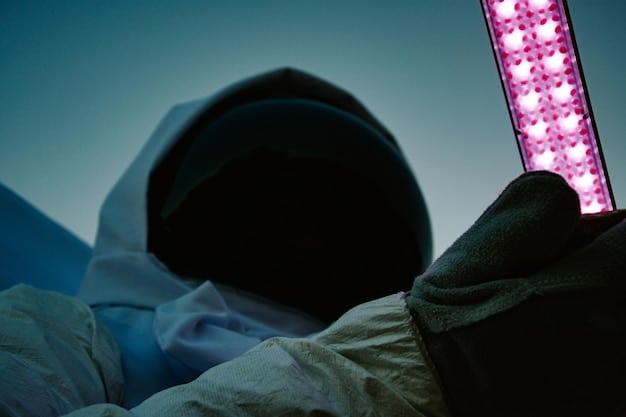DIY Music Videos: Budget-Friendly Techniques for Emerging Artists in the US

Emerging artists in the US can effectively produce high-quality DIY music videos using budget-friendly techniques, leveraging readily available technology, creative storytelling, and strategic post-production to enhance their artistic visibility and audience engagement without significant financial outlay.
In today’s dynamic music landscape, creating compelling visuals is as crucial as producing great audio. For DIY music videos: budget-friendly techniques for emerging artists in the US offer a revolutionary path to connect with audiences and elevate their craft.
Mastering Pre-Production: The Foundation of a Budget-Friendly Video
The success of any music video, especially one created on a tight budget, hinges significantly on robust pre-production. This phase is where concepts are refined, resources are allocated, and potential challenges are anticipated, ensuring a smoother filming process and a more cohesive final product without incurring unnecessary costs.
Developing Your Concept and Storyboard
Before touching any equipment, artists must define the video’s core message and visual narrative. A clear concept directs every subsequent decision, from location scouting to shot composition. This foundational step is critical for maintaining consistency and avoiding costly re-shoots.
- Brainstorm Core Ideas: What story does your song tell? What emotions do you want to evoke? Jot down every idea, no matter how outlandish, and then refine them.
- Create a Detailed Storyboard: Visualizing each shot, scene by scene, helps solidify the narrative. Simple stick figures and notes can suffice, outlining camera angles, character actions, and key visual elements.
- Plan for Practicality: Consider what can realistically be achieved with limited resources. An intricate concept might need simplification to fit a DIY approach.
Having a well-developed concept and storyboard not only guides the production but also helps communicate your vision effectively to any collaborators, making the entire process more efficient. This meticulous planning eliminates guesswork during filming, saving both time and potential expenditures.
Location Scouting on a Budget
Choosing the right location can dramatically impact the visual appeal of your video without breaking the bank. Think creatively about spaces that align with your song’s mood and narrative.
- Utilize Public Spaces: Parks, city streets, and quiet natural landscapes can offer stunning backdrops for free. Always check local regulations regarding filming permits.
- Borrow or Barter: Friends’ homes, local businesses, or community centers might offer unique settings. Consider offering a performance or promotion in exchange for using their space.
- Leverage Personal Spaces: Your own home, backyard, or garage can be transformed with simple lighting and creative staging, offering complete control over the environment.
Effective location scouting involves more than just finding a pretty spot; it’s about identifying places that complement your artistic vision while remaining financially viable. A compelling location can elevate the production value of your DIY music video significantly.
Assembling Your DIY Crew
Building a reliable, small crew is essential. While you might be tempted to do everything yourself, even one or two trusted individuals can make a huge difference in managing logistics, providing feedback, and operating equipment.
Friends with an interest in photography, videography, or even just good organizational skills can be invaluable. Clearly assign roles to avoid confusion and ensure everyone knows their responsibilities. Remember, a well-coordinated team, no matter how small, can achieve far more than a single overwhelmed individual.
In essence, thorough pre-production is the silent backbone of a successful, budget-friendly music video. It allows emerging artists to visualize, plan, and prepare meticulously, turning ambitious ideas into achievable realities without financial strain.
Affordable Equipment and Technology for Quality Footage
Gone are the days when high-quality video production demanded expensive professional cameras and elaborate sound setups. Today’s technology offers a wealth of affordable options that can produce stunning results, empowering emerging artists to capture their vision within a limited budget.
Smartphones: Your Primary Filming Device
Modern smartphones are incredibly powerful tools for video production, boasting high-resolution cameras, impressive low-light capabilities, and advanced stabilization features. For many DIY projects, a smartphone can be the only camera you need.
- iPhone or Android High-End Models: Recent flagship models offer 4K video recording, slow-motion capabilities, and excellent dynamic range. Ensure adequate storage space.
- Utilize External Lenses: Affordable clip-on lenses (wide-angle, macro, fisheye) can add creative depth and versatility to your smartphone’s camera.
- Stabilization is Key: While some phones have built-in optical image stabilization, a small tripod or a gimbal (e.g., DJI Osmo Mobile) can dramatically improve shot stability, making footage look more professional.
Maximizing your smartphone’s potential involves understanding its features and investing in key accessories that enhance its native capabilities. A stable shot with good lighting can often outperform footage from a more expensive camera that lacks proper support.
Lighting Solutions: Illuminating Your Artistic Vision
Good lighting can transform ordinary footage into something cinematic. Fortunately, effective lighting doesn’t require a Hollywood budget; a combination of natural light and inexpensive artificial sources can make all the difference.

- Natural Light: The sun is your best friend. Film outdoors during the “golden hour” (shortly after sunrise or before sunset) for soft, warm light. Indoors, position subjects near large windows.
- LED Panels: Affordable, portable LED panels offer adjustable brightness and color temperature. They are energy-efficient and can be powered by batteries, ideal for varied shooting locations.
- DIY Diffusers and Reflectors: White bedsheets, shower curtains, or even large pieces of white foam board can soften harsh light or bounce light into shadows, creating more flattering illumination.
Understanding how light interacts with your subjects and environment is crucial. Experimentation with natural and artificial sources will quickly reveal the power of thoughtful lighting in elevating your video’s aesthetic.
Audio Recording: Beyond the Built-In Microphone
While the video quality from most smartphones is impressive, their built-in microphones are typically inadequate for professional-sounding audio. External audio solutions are a worthwhile investment for any music video.
- Lavalier Microphones: Small, clip-on mics are inexpensive and great for capturing clear vocals, especially for narrative segments or close-up performance shots.
- Shotgun Microphones: If recording instruments or live performances, a shotgun mic mounted on your smartphone (via an adapter) can capture directional sound and reduce background noise.
- Dedicated Audio Recorders: For the best quality, consider recording audio separately using a portable digital recorder (like a Zoom H1N or Tascam DR-05X) and an external microphone. This allows for higher fidelity and more control during post-production.
Prioritizing clear, crisp audio is paramount. Viewers are often more forgiving of less-than-perfect visuals than they are of poor sound quality. Investing in basic audio gear ensures your music sounds as good as it looks.
Ultimately, the key to affordable equipment and technology lies in strategic choices. Focus on enhancing the fundamental elements of your production—stability, lighting, and sound—using budget-friendly tools. This approach empowers emerging artists to create visually and audibly compelling music videos without the need for extensive capital investment.
Creative Filming Techniques on a Shoestring Budget
Once you have your basic equipment, the real magic begins: transforming creative ideas into compelling visuals. Budget limitations often breed ingenuity, pushing artists to think outside the box and utilize clever filming techniques to maximize visual impact without spending extra money.
Maximizing Your Smartphone’s Potential
Beyond simply pointing and shooting, there are several techniques to get the most out of your smartphone camera and make your footage look more professional. These methods focus on using the camera’s features and your environment strategically.
- Vary Shot Types: Don’t just stick to wide shots. Incorporate close-ups, medium shots, and establishing shots to add visual interest and help tell your story.
- Utilize Depth of Field: If your phone allows, use portrait mode or manual focus to create a shallow depth of field, blurring the background and making your subject stand out.
- Experiment with Angles: Shoot from low angles to create a sense of dominance, or high angles for vulnerability. Unique perspectives can add significant visual flair.
Understanding basic cinematography principles and applying them with your smartphone can elevate your video far beyond what many expect from mobile devices. It’s about how you use the tool, not just the tool itself.
Harnessing Natural Light and DIY Lighting
As previously mentioned, light fundamentally shapes the mood and quality of your visuals. Mastering natural light and employing simple DIY lighting setups can lead to stunning cinematic effects without the need for expensive studio lights.
Consider shooting outdoors during overcast days for soft, diffused light, which is excellent for portraits. Indoors, experiment with positioning subjects near large windows, and use reflective surfaces like mirrors or tin foil to bounce light onto your subject and fill in shadows. Even common household lamps can be repurposed with diffusers (e.g., a white t-shirt) to create soft key lights or fill lights.
The strategic use of light can convey emotion, highlight textures, and guide the viewer’s eye, all critical elements in a compelling visual narrative. Practice and experimentation are key to understanding how different light sources affect your shots.
Practical Effects and Minimalist Set Design
Expensive props and elaborate sets are rarely feasible for DIY music videos. Instead, focus on practical effects and minimalist set designs that enhance the narrative without significant cost.
- Found Objects: Look for everyday items that can be repurposed as props or set dressing. A simple chair, an old book, or a vintage lamp can add character.
- Projection Mapping: Use a projector to cast images or videos onto walls or people, creating dynamic and visually interesting backgrounds. This can be done with an inexpensive home projector.
- Smoke and Fog: A budget-friendly fog machine or even creative use of steam can add atmosphere and depth to your shots, creating a dreamy or mysterious mood.
Sometimes, less is more. A minimalist set, carefully curated with a few key elements, can be far more impactful than an overcrowded one. The goal is to create an environment that supports your story without distracting from the music or the artist’s performance.
These creative filming techniques prove that compelling visuals aren’t reserved for high-budget productions. With ingenuity, a keen eye, and a willingness to experiment, emerging artists can craft professional-looking music videos that resonate deeply with their audience.
Post-Production Prowess: Editing on a Budget
The magic isn’t solely in the shooting; it’s also in the editing room. Post-production is where raw footage transforms into a polished, coherent music video. Thankfully, powerful and affordable editing tools are readily available, making professional-grade results accessible for budget-conscious artists.
Affordable Editing Software Options
You don’t need a professional studio’s budget to access robust editing capabilities. Several user-friendly and powerful software options cater to various skill levels and budgets.
- DaVinci Resolve (Free): This is a Hollywood-grade video editing suite available completely free. It includes professional editing, color correction, visual effects, and audio post-production tools. It has a steeper learning curve but offers unmatched power for a free program.
- HitFilm Express (Free): Another excellent free option, HitFilm Express provides a solid video editor combined with powerful visual effects features. It’s great for adding creative flourishes to your video.
- KineMaster/InShot (Mobile/Tablet, Freemium): For editing directly on your smartphone or tablet, these apps offer intuitive interfaces and a surprising array of features, including multi-track editing, effects, and text overlays.
Choosing the right software depends on your comfort level with editing and the complexity of your vision. Investing time in learning one of these platforms will pay dividends in the quality of your final product.

Color Grading and Visual Effects on a Dime
Color grading can dramatically alter the mood and professional appearance of your video, turning flat footage into vibrant, cinematic scenes. Simple visual effects can also add a unique flair without requiring special effects wizards.
Every editing software listed above offers robust color correction and grading tools. Start by adjusting white balance, exposure, and contrast to ensure your footage looks natural. Then, experiment with color grading to create a specific look – perhaps warm tones for a nostalgic feel, or cool blues for a melancholic mood. Many free LUTs (Lookup Tables) are available online that can apply instant cinematic color grades.
For visual effects, think simple but effective. Overlays (like light leaks or dust
scratches), subtle transitions, and basic text animations can add polish. Avoid overly complex effects that are difficult to execute well without professional software and expertise; often, subtlety is more impactful.
Sound Design and Mixing for Impact
While your primary audio will be your music track, thoughtful sound design can enhance the narrative and emotional impact of your video. This involves adding sound effects and mixing all audio elements effectively.
- Licensing and Royalty-Free Music: Ensure you have the rights to use any music in your video. For sound effects, many websites offer royalty-free sound libraries (e.g., Freesound.org, YouTube Audio Library).
- Balance Audio Levels: The music should be the primary focus, but dialogue or sound effects should be clearly audible without overpowering the song. Use volume keyframes to duck music when voices are present.
- Add Subtle Sound Effects: Footsteps, ambient sounds (e.g., city noise, natural sounds), or specific actions (e.g., door creaking, click of a camera) can add realism and depth to your visuals, even if they are just placeholders for the final master.
A well-mixed audio track ensures a cohesive and immersive experience for the viewer. Paying attention to these often-overlooked details can significantly elevate the perceived quality of your DIY music video.
In essence, post-production is where your vision truly comes to life. By leveraging powerful, free, or low-cost software and focusing on meticulous editing, color work, and sound design, emerging artists can produce a polished, professional-looking music video that captivates their audience.
Distribution and Promotion: Getting Your Video Seen
Creating a compelling DIY music video is only half the battle; the other half is ensuring it reaches your target audience. Strategic distribution and promotion are just as crucial as the production itself, especially for emerging artists looking to maximize their reach on a limited budget.
YouTube: Your Primary Platform
YouTube remains the undeniable king for music video distribution. It’s not just a hosting platform; it’s a powerful discovery engine. Optimizing your video for YouTube is paramount for visibility.
- High-Quality Uploads: Always upload the highest resolution and quality file possible. YouTube will compress it, but starting with the best ensures better final playback.
- Optimized Titles and Descriptions: Use relevant keywords in your title and description, including your artist name, song title, and genre. Write a detailed description that links to your other social media, streaming platforms, and website.
- Tags and Categories: Utilize YouTube’s tagging system with relevant keywords. Categorize your video correctly (e.g., “Music”).
- Custom Thumbnail: A compelling thumbnail can significantly increase click-through rates. Design a custom image that is eye-catching and accurately represents your video.
Beyond the technical aspects, consistency is key. Regularly uploading content and engaging with your audience on YouTube builds a loyal following. Promote your YouTube channel actively across all your other social media platforms.
Social Media Strategy: Spreading the Word
Social media platforms are essential for driving traffic to your music video. Each platform has its unique strengths and audience, so tailor your content and approach for maximum impact.
On Instagram and TikTok, create short, engaging teasers or behind-the-scenes clips that encourage viewers to click the link in your bio for the full video. Use relevant hashtags and trends to increase discoverability. Facebook can be used to share the full video directly or link to YouTube, engaging with fan pages and music groups. Twitter is excellent for quick updates, sharing links, and interacting with other artists and industry professionals.
Consider running micro-campaigns on each platform leading up to your video release, building anticipation. Engage with comments and messages to foster a sense of community around your work.
Engaging with Blogs and Playlists
Beyond direct fan engagement, seeking external promotion can significantly amplify your video’s reach. Music blogs and curated playlists are powerful discovery tools for emerging artists.
- Research Relevant Blogs: Find music blogs that cover artists in your genre and have an audience that aligns with yours. Many smaller, independent blogs are more open to reviewing emerging artists.
- Craft a Professional Pitch: When contacting blogs or playlist curators, personalize your message. Briefly introduce yourself, explain why your video is a good fit for their audience, and provide easy access to your video (e.g., a private YouTube link or a direct link to the public video).
- Submit to Curated Playlists: Platforms like Spotify and Apple Music have many independent curators who run popular playlists. Research relevant playlists and follow their submission guidelines.
While outreach can be time-consuming, a single feature on a popular blog or inclusion in a widely followed playlist can expose your music to thousands of new listeners. Persistence and a professional approach are vital in this aspect of promotion.
Ultimately, a successful music video isn’t just about its creation but also its strategic dissemination. By leveraging YouTube’s robust platform, engaging effectively on social media, and pursuing external opportunities with blogs and playlists, emerging artists can ensure their DIY music videos receive the attention they deserve, connecting with a broader audience and furthering their artistic journey.
Building Your Brand and Community Through DIY Videos
DIY music videos are more than just promotional tools; they are powerful instruments for emerging artists to define their brand, express their unique artistic identity, and cultivate a dedicated community of fans. In the competitive music industry, authenticity and connection often outshine lavish budgets, making DIY efforts particularly impactful.
Showcasing Authenticity and Personality
One of the greatest advantages of DIY videos is the opportunity for raw, unfiltered authenticity. Without a large production team, artists have full creative control, allowing their true personality and artistic vision to shine through.
- Embrace Imperfection: Small imperfections can often add charm and relatability, reinforcing your DIY ethos. Don’t strive for unattainable Hollywood perfection; aim for genuine expression.
- Tell Your Story: Use the video to convey a personal message, share a glimpse into your creative process, or highlight what makes you unique as an artist. This transparent approach builds a stronger connection with viewers.
- Reflect Your Style: Let your fashion, environment, and visual choices align with your musical genre and personal aesthetic. Consistency in branding helps solidify your artistic image.
Authenticity resonates deeply with audiences, fostering trust and loyalty. When fans feel they are getting to know the real artist, they are more likely to support their journey and spread the word about their music.
Engaging Your Audience Beyond the Screen
A music video is a starting point for engagement, not the end destination. Encourage interaction and build a reciprocal relationship with your viewers, turning passive watchers into active community members.
Respond to comments on YouTube and social media. Ask open-ended questions in your video descriptions or social posts to spark conversation. Consider live Q&A sessions or behind-the-scenes glimpses to make your audience feel part of your creative process. Encourage user-generated content, such as cover songs or dance challenges inspired by your video, amplifying your reach through organic fan advocacy.
Building a community goes beyond mere numbers; it’s about fostering genuine connections and creating a space where fans feel valued and heard. This active engagement turns viewers into advocates for your brand.
Leveraging Analytics for Growth
Most distribution platforms, especially YouTube, provide valuable analytics about your video’s performance. Understanding these metrics can guide your future content strategy and help you better connect with your audience.
- Audience Retention: Pay attention to where viewers drop off. This can indicate segments that are less engaging and help you refine future video pacing.
- Demographics: Learn about your audience’s age, gender, and geographical locations. This information can inform future promotional targeting and content themes.
- Traffic Sources: Understand where your viewers are coming from (e.g., YouTube searches, suggested videos, external websites). This insight helps you double down on effective promotion channels.
Using analytics isn’t about chasing viral hits; it’s about making informed decisions to incrementally improve your content and reach. Each video teaches you something new about your audience and what resonates with them.
Ultimately, DIY music videos empower emerging artists not just to release content, but to sculpt their public image, connect authentically with a growing fanbase, and strategize their growth based on real data. They are a testament to the idea that creativity and connection are far more valuable than limitless budgets.
Common Pitfalls to Avoid in DIY Music Video Production
While DIY music video production offers incredible freedom and cost savings, certain common pitfalls can undermine even the most creative efforts. Awareness of these potential issues allows emerging artists to proactively address them, ensuring a smoother production process and a higher quality final product.
Neglecting Audio Quality
One of the most frequently overlooked aspects in DIY video is audio. While visually stunning footage is important, poor sound quality can instantly turn off viewers. Muddy vocals, excessive background noise, or out-of-sync audio will detract significantly from the overall experience, regardless of how good the visuals are.
Always prioritize capturing clean, clear audio separately from your video. Even if your equipment is basic, proper microphone placement and recording in a quiet environment are crucial. Remember, viewers are often more forgiving of less-than-perfect visuals than they are of bad sound.
Poor Planning and Lack of Storyboard
Rushing into filming without a detailed plan is a recipe for disaster. A lack of structure often leads to incoherent narratives, wasted time on set, and crucial missed shots during editing. This inefficiency not only impacts the final quality but can also lead to unnecessary expenses or delays.
Devote ample time to pre-production: brainstorm your concept thoroughly, create a detailed storyboard for every shot, and develop a realistic shooting schedule. The more prepared you are, the smoother and more efficient your filming process will be, ensuring your vision is captured effectively.
Over-reliance on Special Effects
It’s tempting to want dazzling visual effects, but for DIY productions, trying to implement complex CGI or intricate visual effects can quickly become overwhelming, time-consuming, and often yield amateurish results if not executed professionally. An ambitious effect that looks poorly done can be more distracting than beneficial.
Focus on practical effects, strong cinematography, and compelling storytelling. Simple, well-executed effects often look far better than complex ones that are attempted without the necessary skills or software. Subtlety and impactful visuals achieved through framing, lighting, and performance are usually more effective.
Inconsistent Visuals and Mood
A common issue in DIY videos is a lack of visual consistency. This can manifest as wildly varying lighting conditions between shots, inconsistent color grading, or a disjointed narrative that jumps erratically from one mood to another. Such inconsistencies confuse the viewer and make the video feel unprofessional.
Maintain a consistent visual style throughout your video. Pay attention to lighting, shot composition, and camera angles. During post-production, use color grading to unify the look and feel of your footage. Ensure your narrative and visual elements consistently support the mood and message of your song.
Ignoring Legal and Copyright Issues
While exciting to create, it’s easy to overlook crucial legal aspects. Using copyrighted music, uncredited samples, or footage of locations without proper permission can lead to your video being taken down, legal disputes, or monetization issues on platforms like YouTube.
Always ensure you have the necessary rights for all audio, visual, and intellectual property used in your video. Use royalty-free music and sound effects, secure location permits if required, and obtain releases from any actors or individuals identifiable in your footage. Ignorance of copyright law is not a valid defense.
By being mindful of these common pitfalls, emerging artists can navigate the challenges of DIY music video production more effectively. Proactive avoidance of these issues safeguards the quality of your output and optimizes your efforts, allowing you to create a truly impactful visual story for your music.
| Key Aspect | Brief Description |
|---|---|
| 🎬 Concept & Planning | Thorough pre-production, including storyboarding & location scouting, is crucial for efficiency. |
| 📱 Affordable Gear | Leverage smartphones, natural light, and external mics for professional results on a budget. |
| 💡 Creative Techniques | Innovative framing, DIY lighting, and simple practical effects elevate visual appeal. |
| 🚀 Distribution & Impact | Optimize for YouTube and social media; build brand and community through authenticity and analytics. |
Frequently Asked Questions About DIY Music Videos
▼
The most essential piece of equipment for a DIY music video is undoubtedly your smartphone. Modern smartphones offer incredible video capabilities, often comparable to entry-level professional cameras. Paired with a good external microphone for superior audio, your smartphone can serve as the backbone of a high-quality video production, making it accessible to artists on a tight budget.
▼
Pre-production is incredibly important, arguably more so for budget-friendly videos. Thorough planning, including concept development, storyboarding, and location scouting, saves immense time and money during filming. It eliminates guesswork, minimizes errors, and ensures a cohesive final product, preventing costly reshoots and optimizing the utilization of limited resources and time.
▼
Yes, achieving good audio quality on a budget is absolutely possible. While smartphone microphones are generally insufficient, an affordable external lavalier or shotgun microphone can significantly improve sound capture. Recording audio separately using a dedicated portable recorder often yields the best results. Prioritizing clear audio is crucial, as poor sound can detract more than imperfect visuals.
▼
For robust, professional-grade editing, DaVinci Resolve is widely considered the best free option. It offers a comprehensive suite of tools for editing, color grading, visual effects, and audio post-production. While it has a steeper learning curve, its capabilities are unmatched among free software. HitFilm Express is another excellent choice for those focusing on visual effects.
▼
Emerging artists can effectively promote their DIY music videos by optimizing for YouTube with strong titles, descriptions, and thumbnails. Leverage short, engaging teasers on social media platforms like Instagram and TikTok, linking back to the full video. Additionally, strategically pitching to relevant independent music blogs and curated playlists can significantly expand reach and connect with new audiences.
Conclusion
The journey of creating a high-quality music video on a budget is a testament to the power of creativity, meticulous planning, and accessible technology. For emerging artists in the US, the era of needing substantial financial backing to produce compelling visuals is effectively over. By embracing thoughtful pre-production, leveraging affordable yet powerful equipment like smartphones, employing ingenious filming techniques, and mastering free post-production tools, artists can craft narratives that resonate deeply with their audience.
More than just a promotional asset, a DIY music video is an extension of an artist’s brand—a canvas for authenticity and a catalyst for community building. It provides an unparalleled opportunity to tell a unique story and forge genuine connections. While challenges exist, understanding and avoiding common pitfalls ensures that the creative energy invested translates into a polished, impactful product. Ultimately, the budget-friendly approach empowers artists to take control of their visual identity, proving that passion, ingenuity, and strategic execution are far more valuable than limitless funds in the evolving music landscape.





